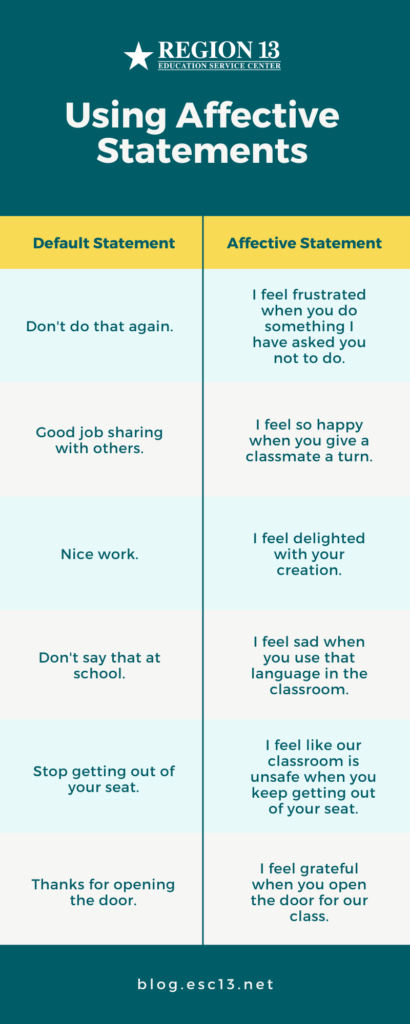Restorative practices is an alternative discipline method that focuses on building healthy relationships between students and adults in educational settings to decrease recidivism and change harmful behavior. It is the vehicle that allows students and individuals to learn from their mistakes and make amends for wrongdoing.
Additionally, restorative practices have specific tools to address conflict, hold individuals accountable, and repair/restore relationships. Affective statements are one tool you can immediately incorporate into the classroom.
Characteristics of Affective Statements and Language
First, affective language provides a structure for reinforcing desired behaviors and challenging/ redirecting unwanted behaviors. Similarly, it is the genuine expression of feelings, impacts, and emotions about specific student behaviors and actions.
Here are some specific characteristics of affective language:
- Can be “I” statements that express a feeling.
- Make students aware of their behavior’s positive or negative impact.
- Provide a precise description of a student’s behaviors and the specific impact of those behaviors.
- Do NOT protect students from the consequences of their behavior.
- Strategically delivered in a time frame, place, and manner most likely to maximize impact.
- Are delivered in a personalized manner directly to the student who impacted others.
- Focus on the behavior, NOT on the person’s intrinsic worth (separates the deed from the doer).
- Are respectful in tone.
- Encourage students to express their feelings.
- Use five positives to one corrective statement.
For affective statements to be productive, remember to use a calm voice. Your job is to understand all viewpoints in the disagreement, not decide who is right or wrong. Then wait and let the students come up with solutions on their own, if possible.
Affective Statement Sentence Stem Examples
Now that you understand the methodology of affective statements, let’s dive into some specific sentence stems you can use when interacting with students.

- I feel proud to see/hear…
- I feel excited to see/hear…
- I am appreciative of you/your…
- I am thankful that/for…
- I feel delighted to learn/see/hear …
- I am impressed by…
- I am touched that you…
- I feel worried about/by/to see/to hear that…
- I feel frustrated about/by/to see/to hear that…
- I feel angry about…
- I am sorry that…
- I am having a hard time understanding…
- I feel uncomfortable when I see/hear…
- I feel sad because I heard…
- I feel distracted by…
If you are not used to using affective statements, it can be difficult at first to increase your use of them. However, be patient with yourself because changing habits can take time and practice.
One way to practice is to prompt yourself to use these skills. You may want to post sticky notes as reminders. In addition, you may want to post vocabulary sheets around your classroom to give additional words to use.
Finally, consider setting goals for how many affective statements you will use daily. Tracking your usage will help you reflect on your progress.
Stakeholder Recommendations
Building restorative practices on your campus takes commitment from all stakeholders. For example, in The Restorative Practices Playbook: Tools for Transforming Discipline in Schools, the authors share how you can involve every group in understanding affective statements.
Schoolwide – Participate in professional learning about cognitive reframing and affective statements, and practice short role-playing scenarios regularly as a staff.
Leaders – Note your use of affective statements and cognitive reframing in your interactions.
Teachers – Identify opportunities to use cognitive reframing and affective statements in classroom interactions. Share these with your grade level or department
Students – Teach students about the usefulness of identifying emotions and using affective statements to resolve small conflicts with peers.
Family and Community – Let families know about your work on cognitive reframing and affective statements through venues where you share information about the school (newsletters, website).
Finally, using tools for restorative practices like affective statements can help resolve conflict and establish a positive learning environment for all students.
Lisette is a Behavior Specialist and Facilitative Mediator here at ESC Region 13.






Add comment